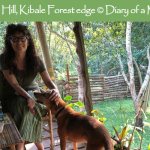
10 fascinating facts (I bet you didn’t know) about flamingos!
Flamingo-watching, horse riding among zebras, a game drive in search of elands, giraffes and Secretary Birds – what more can a girl ask for? Sigh… read about my three action-packed days at the luxurious Lake Elmenteita Serena Camp, Soysambu Conservancy in Kenya’s Rift Valley.
For many years I’ve had a postcard decorated with bright pink birds next to my desk. Seeing flamingos in their natural environment has been high on my African travel bucket list for longer than I remember. Although flamingos are occasional visitors to Uganda, their numbers are low and their arrival unpredictable. I was therefore thrilled to have the opportunity to visit Kenya’s Lake Elmenteita, a UNESCO World Heritage Site and Important Bird Area, famous for its flamingo and pelican populations.
Lake Elmenteita Serena Camp has a superb range of activities for the active (and the not so active!) Horse riding, game drives, archery, a lakeshore breakfast, birdwatching and the Serena’s wonderful Maisha Spa are just a few highlights. Would the muzungu be able to fit them all in my three-day stay? (If you know me, you know I want to try everything!)
Scroll down for 10 Fascinating Facts about Flamingos.
As soon as I stepped out of the vehicle, my eyes were drawn to Lake Elementeita and the hill known as the Sleeping Warrior (AKA Lord Delamere’s Nose). Between us lay a chink of shining water. Were the flamingos there?
Checking into my luxury tent cum cottage would have to wait while I peered at the lake – and there it was! – a fine line of pink and the most extraordinary noise. (I was to become familiar with the funny noises that feeding flamingos make!)
Flamingos are so unusual that my mind raced with questions about their pink appearance, their unusual beak and their quirky dance! If you’re curious like I am, you might enjoy the tips I collected about these fabulous and unique birds.
10 Fascinating Flamingo Facts
Who can fail to identify a flamingo? These leggy tropical wading birds have long curvy necks. Most noticeably of all, they are pink!
Flamingos are water birds that live in and around lakes and lagoons. In East Africa, these waters are usually saline or alkaline.
Did you know… ? The pinkest flamingos have the highest status as their bright colour shows that the bird is good at finding food and thus strong.
Fun Flamingo Fact #1
Why are flamingos pink?
Flamingos embody the phrase “you are what you eat” and consume a diet of small fish, shrimps and crustaceans that live on lake algae. The pink comes from beta-carotene in the crustaceans.
Did you know… ? Flamingos that live in zoos will turn white if their diet is not supplemented with live shrimp or food containing carotenoid pigments.
The number of pink birds is increasing – this is a new thing according to my guide at Lake Elmenteita Serena Camp. Other birds such as Yellow-billed Stork can be affected and you may see a pink tinge to their wings.
Flamingos are pink on the inside, too. Flamingo skin is pink; so is flamingo blood!
Fun Flamingo Fact #2
There are six species of flamingo. Two are native to East Africa.
The Greater Flamingo (Phoenicopterus roseus) is the most widespread flamingo species. Greater Flamingos are bigger and have a defined S body shape.
The Lesser Flamingo (Phoenicopterus minor) is the most numerous species of flamingo. Lesser Flamingos are smaller but pinker!
Did you know… ? Both flamingo species can be seen at Lake Elmenteita.
Fun Flamingo Fact #3
Did you know… ? Flamingos feed upside down while dancing? They hold their breath while feeding too!
Their feet disturb the lakebed and release algae. With their head upside-down, they suck the muddy water and filter the lake’s nutrient through their specially designed beak.
Fun Flamingo Fact #4
Groups of flamingos are known as colonies and may number several hundred birds. In East Africa, more than one million flamingos have been known to flock together.
Did you know… ? As breeding time approaches, a high-status flamingo will influence the rest of the flock to breed by changing its feathers to a deeper shade of pink, kick-starting the breeding rituals. Isn’t that amazing?
Fun Flamingo Fact #5
Did you know… ? A colony of flamingos all mate at the same time so chicks all hatch at the same time.
Flamingos are monogamous and produce one egg each year. The pair build a nest of mud and sticks and take turns to sit on the egg while it incubates. When a flamingo chick hatches, after a month, both parents take turns to feed it. Their straight beaks start to curve as they grow. Flamingo chicks are born white or grey and take up to 3 years to reach their mature pink colour
Flamingos breed on Lake Natron in Tanzania but spend most of their year on lakes in Kenya.
Fun Flamingo Fact #6
Did you know… ? You can see flamingos (those that are not breeding) throughout the year at Lake Elmentaita.
The breeding flamingos – and young – return to Lake Elmenteita from May onwards. During June 2018, there were more flamingos here than ever: almost the whole lake was covered, according to my guide at Lake Elmenteita Serena Camp.
From late December to January flamingos fly to their breeding ground on Lake Natron in Tanzania. A number always remain at lake Elmentaita – with the large pelican population – throughout the year.
Fun Flamingo Fact #7
Did you know… ? Although flamingo numbers are fairly stable, Lesser Flamingos are considered near threatened because their numbers are small or decreasing, according to the IUCN (International Union for the Conservation of Nature).
Fun Flamingo Fact #8
Flamingos live between 20 and 30 years, some longer. They have one of the longest lifespans in the bird world.
Did you know… ? Fossil remains show close relatives of the flamingo existed around 30 million years ago. This makes them one of the older bird species
Fun Flamingo Fact #9
Do you know why flamingos stand on one leg when they want to rest? It’s been suggested that having one leg out of the water preserves body heat.
A flamingo knee bends backwards (and is covered in feathers). The “knee” that we see is actually an ankle joint.
Fun Flamingo Fact #10
The word ‘flamingo’ comes from the Spanish word ‘flamenco’ meaning fire, which refers to the bright colour of their feathers (naturally!)
The spacious tented accommodation at the 4-star Lake Elmenteita Serena Camp is a clever combination of fixed walls and canvas that rolls up to reveal mosquito-netted windows. Each cottage has a private view of the lake.
Rooms are furnished with colonial-style furniture: a wooden floor, a large desk complete with cubbyholes for letters, a desk lamp, a hefty wooden chest with brass fittings, a day bed, a dressing table, and overhead a chandelier (of course) and framed prints of some of East Africa’s most exotic birds such as the flamboyant Northern Carmine Bee eater, and Lilac-breasted Roller.
I had two delicious nights sleep on a ridiculously comfortable mattress. I was in seventh heaven when I found hot water bottles warming my bed! Mosquito nets drape around the four-poster bed and fall to the floor. My bathroom had ‘double vanities’ (twin basins); it had two of everything in fact – even a double ‘his and her’ shower! Toiletries are provided in large wall dispensers. (Lake Elmenteita Serena Camp is Gold Eco-rated after all!) Each cottage is well connected with power sockets, a phone and plenty of hot water.
About Lake Elmenteita Serena Camp
- The 25 luxury tented accommodation can sleep up to 50 people.
- The Flamingo Suite is the closest accommodation to the lake and perfect for honeymooning couples.
- Complimentary activities include cooking with the chef, watercolour painting, a botanical tour, archery, Swahili lessons and yoga
- Other (charged) activities include night game drives, massages and bush dinner.
- The swimming pool is gorgeous!
- There is a small ‘conference tent’ that can be set up for up to 35 people
For more information…
- Why not combine a stay at Lake Elmentaita with a few days at the Nairobi Serena Hotel? Read my blog ‘How to tour Africa from the comfort of your Nairobi hotel.’
- Rates are usually based on full board and include Soysambu Conservancy fee and numerous (but not all) activities; mineral water or soft drinks with meals. Family offer: children under five years sharing rooms with parents stay free.
Travel tips and Directions to Lake Elmenteita Serena Camp
- The journey by road from Nairobi takes 2 1/2 hours. Distance from Nairobi 135 km; Nakuru 30 km; Nakuru National Park (Nderit gate) 27 km.
- Fly by private plane or charter to nearby airstrip.
- Land a helicopter at the camp’s helipad.
- The final approach to the Conservancy is on a good new road. Within five minutes we were in dusty bush and almost immediately saw bushbuck, warthog and impala.
- The Soysambu Conservancy was created in 2007 and is known as a ‘dual land use’ conservancy of wildlife with livestock. The Conservancy’s 48,000 acres (190 square km) protects 12,000 wild animals (including Rothschild’s giraffe, zebra, eland, buffalo, leopard and lion), 7,000 cattle and 4,000 goats and sheep. The conservancy is clean, quiet and isolated from modern life. (I found comfort in not seeing any human activity on the lake).
- Visitors to the Conservancy can only gain entry by booking in advance. This policy is because the Conservancy’s infrastructure can only support a limited number of vehicles. This limited access gives pre-booked visitors an exclusive experience. Book through the Conservancy’s tourism partners (such as Lake Elmenteita Serena Camp) or camp.
- Soysambu is very accessible and you don’t need a four-wheel-drive. If you buy a map of the conservancy then you don’t need to hire a guide.
- For additional wildlife excitement, Nakuru National Park is a stone’s throw away and home to a few species you can’t see at the Conservancy, including white rhino, black rhino, striped hyena and elephant.
- By comparison, conservancy fees are very affordable (and included in the rates for staying at Lake Elmenteita Serena Camp).
Read full details about Lake Elmenteita Serena Camp’s facilities in my Travel Directory.














![Where is the best place to stay for gorilla tracking in Rwanda? [UPDATED]](jpg/featured-thumb.jpg)












Wow thank you for all the flamingo facts. I never thought it’s their ankle and not their knee!
Hi, I’m also want that horse ride ..
Thanks for sharing beautiful images of this memorable trip…